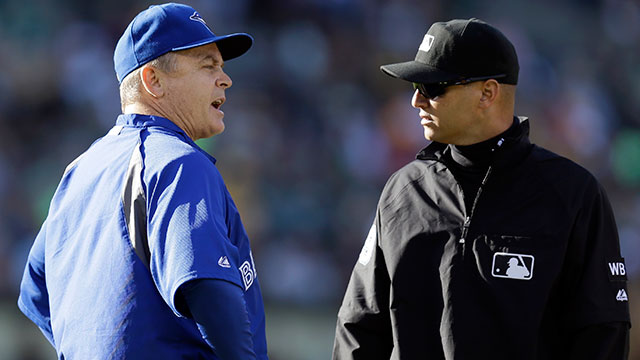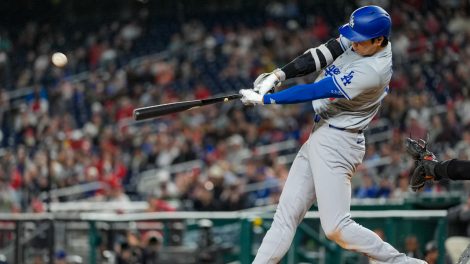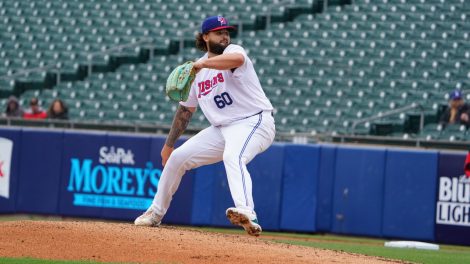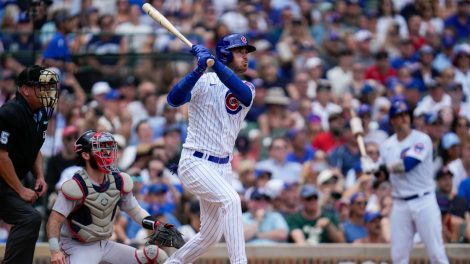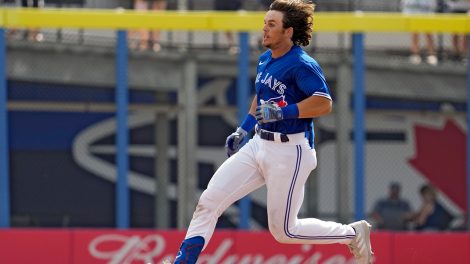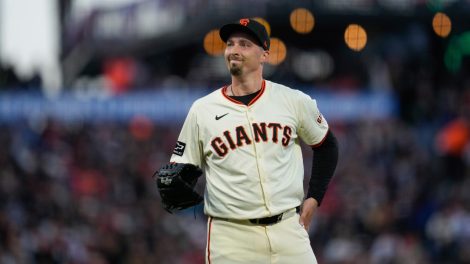NEW YORK – Decisions that impact pennant races, statistical pursuits and, ultimately, contract negotiations are made here. You have to remember that sometimes as you stand in the middle of the Replay Operations Center at the offices of Major League Baseball Advanced Media, located in the heart of New York’s trendy Chelsea district.
YouTube is a freight elevator ride away in the chic Chelsea Market building, Google is across the street, and chic restaurants that serve quinoa and kale abound. In the roughly 1,000 square foot room where umpires are asked to affirm or overturn calls their colleagues make in the field, there are 51 screens ringing three of the four walls. Give it a long marble counter-top, a busty bartender and two grim-faced bouncers and it would be a place to lounge for dudes in skinny jeans, ironic T-shirts and oversized glasses. But no, decisions that elate and frustrate are made here every day baseball is played.
The actual inhabitants of the Reply Operations Center, or ROC as it’s often called, typically include six active umpires, six video technicians and a handful of MLB officials, a senior executive like replay director Justin Klemm among them. Guests can include anyone from commissioner Bud Selig to delegations from teams in New York to play the Yankees or Mets curious to see how things go down. As chill a spot as it could be, the ROC is actually a very stressful place.
As of the all-star break, the ROC reviewed 728 plays, overturning 347 calls on the field (47.7 percent). Of the remaining challenges, 172 plays were confirmed (23.6 percent), 202 calls stood (27.7 percent), meaning there wasn’t sufficient evidence to change the call, and seven (one percent) were for record-keeping matters like checking the count. The average review lasted one minute 49 seconds, which is pretty good considering the finer points of how replay would work were being ironed out during spring training. Mistakes still happen and improvements are needed, but hundreds of wrong calls have already been corrected and dozens more will be before the season is out. If we’re going to be real about it, despite all the glitches and complaints, Major League Baseball’s bold departure from its tightly held traditions has gone far smoother than expected.
“We’re getting more calls correct,” says Peter Woodfork, who oversees the umpires as MLB’s vice-president of baseball operations. “We want to try to go faster, have more consistency in our clear and definitive calls, what to overturn and what to let stand. … Are we perfect? Absolutely not. But our clubs and our fans have told us that this is better than we were before, and that’s all we’re trying to do.”
The process begins roughly three hours before the day’s play starts, when the video technicians review which camera angles from both the home and visiting broadcast feeds are available and settle on the six best ones from each (some broadcasts feature more camera angles, but they are typically locked in on off-the field locales such as the dugout or bullpen). Each tech sets up at one of the six permanent or three floater workstations that feature 15 screens, including four 46-inch monitors, and sits alongside an umpire who is responsible for monitoring two games at once.
Together they watch for close plays that may end up in review, trying to figure out which camera angles will be most helpful for the situation in question (officials are keeping track of which angles tend to be best for plays most often challenged, like out calls at first base, in an effort to help shorten review times). Once a manager challenges a play – he needs to be specific about what he wants reviewed, although it’s recommended he also ask that the entire play be looked at – and the umpires on the field (the crew chief and whoever made the call in dispute) put on their headsets, the typically quiet ROC is filled by what one official described as an “adrenaline surge.”
The video techs, operating at the review ump’s direction, will call up the different angles on the big screen and slow things down at 60-300 frames per second, depending on the quality of the camera being used at the ballpark. During this time the umpire at the ROC typically asks his counterpart on the field what he saw in regards to the call (for example, “I saw the right hand touch the bag ahead of the tag on his shoulder”) and will look to see whether that holds true.
He may also ask what the umpire heard on the field (like, “I heard the ball hit the glove before his foot touched the base”) because the replays don’t have audio and umpires sometimes use sound and sight on the field to make a call. An umpire’s positioning – did he get a clear view? – gets taken into account, too.
On particularly close plays, the review umpire might call over his counterpart at the next terminal for a second opinion, but the call always rests on his shoulders. The techs have the ability to blow up four different angles at the same time to really isolate key moments, and the standard needed to overturn a call is clear and definitive evidence. This is frequently a point of friction between the various stakeholders because as Woodfork readily acknowledges, “what’s clear and definitive to you may not be as exactly as clear and definitive to me.”
“That’s where bias comes in,” he adds, “and an umpire has nothing in the game besides trying to get the call right versus a team or a fan that might see something slightly differently because they have that passion.”
Such investment means suggestions on ways to improve the process are a dime a dozen around the game, everything from eliminating the ability of teams to review a play internally before making a challenge, to replacing the active umpire crews rotated into the replay centre with impartial fourth parties, in this case.
Everyone’s got some gripes, and a low point came July 5 in Oakland when Toronto Blue Jays slugger Jose Bautista, angry that a pivotal out call on a disputed tag on Melky Cabrera at home plate wasn’t overturned, ranted that “this whole replay thing has become a joke in my eyes. I think they should just ban it, they should just get rid of it, I don’t really understand the purpose of it, but getting the right call on the field is not the purpose. That’s pretty obvious and evident.”
Later he added: “Unfortunately some people, I don’t know what the right word is, lack of integrity, lack of accountability, or some really good camaraderie that are looking after each other, are not doing what they’re supposed to be doing.”
A few days later Joe Torre, MLB’s executive vice-president, met privately with Bautista in Anaheim and decided not to fine the slugger for his comments, instead trying to coax him into giving a system still finding its way some latitude for mistakes.
“To me it’s more important to try and have him understand our perspective on this,” Torre says in explaining why he opted not to fine Bautista. “It’s the same as managing players, they have to understand how you’re thinking and what you’re thinking and the process.”
“I’m not concerned about acceptance in the clubhouse,” Torre adds, “but leaders, whether they’re running across the field wanting to fight or calm the waters, they’re the ones who are going to be looked at as to how should we act. It was important for me to chat with him, and we did talk about the leadership aspect of it.”
Part of Bautista’s complaint, one shared by others, is about a perceived lack of transparency relating to decisions made in the ROC. While there’s a hotline teams can phone into after the fact to request an explanation of why a certain call was or wasn’t overturned, by then it’s too late to ease anger or frustration over the decision. The same thing goes with the renderings of a review panel consisting of a former player, umpire and manager plus a couple of executives who are asked to offer their judgments on any disputed replay decisions. The panel was unanimous on the Cabrera play – the out call was the correct one.
Still, mistakes have been made, too, most famously in early April when the foot of Dean Anna, then of the New York Yankees, came off the bag at second base as Xander Bogaerts of the Boston Red Sox was applying the tag, but the safe call was upheld because “the conclusive angle wasn’t available immediately,” an MLB spokesman said at the time. One of the most blatant misses involving the Blue Jays came June 26 against the Chicago White Sox, when there was video showing clearly that Steve Tolleson beat a throw to first base but the out call was upheld after a 3:29 review.
“That’s going to happen, they’re humans in that pressure moment, they’re fighting with a call that’s really close, we understand that, we just hope we can limit those misses,” says Woodfork. “We haven’t eliminated mistakes, we’re not going to get all the way to eliminating them, but we’ve definitely improved on that process.”
Amid high stakes and surging emotions on the field, there is little tolerance for those mistakes, but it’s easy to forget that this expansion of replay is still in its relative infancy. Everyone is still learning and they’ve been learning under the spotlight. Officials at the ROC joke now about how hectic things felt when three reviews came in at once after experiencing seven challenges in 15 minutes and eight in 22. They survived those tests and now they also point to some unexpected positive by-products of having active umpires handle the reviews, such as discussions about positioning on the field and how to handle the inevitable mistakes that are made both on the field and off it. Umpires are also getting over the reluctance to correct their counterparts.
A wider post-mortem of the entire replay system will come during the off-season when all parties – players, owners and umpires – revisit what went well, what didn’t and how things can be made better for 2015. In the interim, that cool little room where decisions get made will keep on trying to make things right, likely never destined to become hip, but perhaps one day becoming accepted.

